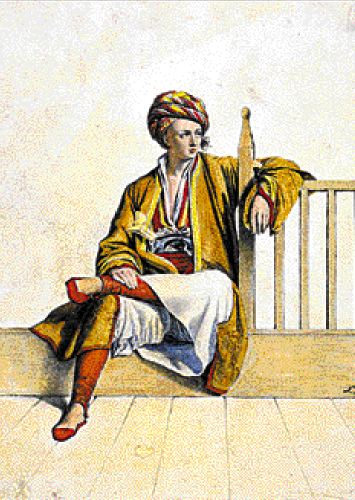 |
||
|
A History of Greek Costume in Print |
||
|
Christy Papadopoulou
Athens News WESTERN travellers on a sightseeing mission to Greece were not just interested in landscapes and archaeological sites. The country's inhabitants, their costumes, daily life and traditions have been a recurrent theme in prints from the 16th century onwards. These ethnographically compelling testimonies - whether authentic or interpretative - have been brought together in ID Koilalou's collection displayed at the Benaki Museum through to November 12. Originally a collector of stamps, Koilalou has through the years acquired a significant number of printed renditions of Greek costumes spanning the period from the 16th to the 20th centuries. He transferred his collection to the Benaki Museum upon the agreement that the donated material would be displayed by means of an exhibition as well as providing the main source for a publication. |
 'Youth from Thessaly', 19th-century lithograph |
|
|
The Benaki's exhibition, which leaves out the photography-oriented 20th-century works, features 220 prints - wood-engravings, copper-engravings and lithographs - out of the collection's 550 which have been added to the museum's already existing costume archive. Brides, officers, sailors, egg sellers and noblemen parade from this imaginary wardrobe museum which unravels geographically, starting from Thrace and Macedonia and comes to a close with the Ionian islands. Costumes often denote societal rank or professional status and in other cases contribute towards capturing the mood of daily life - through a birth or funeral scene or a fair. While in one respect a treasure of visual testimonies of the dress repertoire of Greece's residents, the prints are often fanciful recreations of what westerners saw. "These are works of art and as such they are prone to deviations from the original source of inspiration," curator Fani-Maria Tsigakou told a press meet. Rather than being executed on the spot, many of the sketches followed a traveller's narration or written account and, in effect, are westernised versions of the original. However, this 'touristy' approach does not reduce their worth. "There are elements which allow the reconstruction, even in part, of costumes which have vanished through the years," said Tsigakou. * Greek Costume: Printed Sources 16th-19th Centuries is on at the Benaki Museum (1 Koubari St) till November 12. Open: Monday, Wednesday, Friday and Saturday 9am-5pm, Thursday 9am-midnight; Sunday 9am-3pm; Tuesday closed. A fully-illustrated publication (in Greek) is available from the museum's giftshop at 80 euros
|
||
(Posting date 13 October 2006)
All articles of Athens News appearing on HCS have been reprinted with permission. |
||
|
||
|
2000 © Hellenic Communication Service, L.L.C. All Rights Reserved. http://www.HellenicComServe.com |
||

